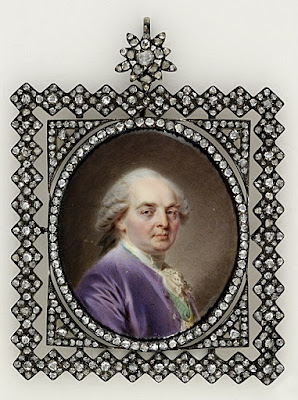 |
| attributed to Jean Mussard Portrait of a Man ca. 1710 enamel miniature Musée du Louvre |
 |
| Christian Friedrich Zincke Portrait of John Gay ca. 1725 enamel miniature Musée du Louvre |
 |
| Noah Seaman Portrait of Georg Friedrich Handel 1741 enamel miniature Musée du Louvre |
 |
| Jean-André Rouquet Portrait of the Duchesse de Villeroy ca. 1750 enamel miniature Musée du Louvre |
 |
| Jean-André Rouquet Portrait of the Marquis de Marigny ca. 1750 enamel miniature Musée du Louvre |
 |
| Jean-André Rouquet Portrait of Francis I, Holy Roman Emperor (father of Marie Antoinette) ca. 1750 enamel miniature Musée du Louvre |
 |
| attributed to Jean-André Rouquet Portrait of Louis XV ca. 1750 enamel miniature Musée du Louvre |
 |
| Henry Spicer Portrait of Esther, Countess of Sussex ca. 1775 enamel miniature Musée du Louvre |
 |
| Jacques Mauris Self Portrait ca. 1775-85 enamel miniature Musée du Louvre |
 |
| Jean-Baptiste Weyler Portrait of a Man ca. 1780 enamel miniature Musée du Louvre |
 |
| Jean-Baptiste Weyler Charles-Claude Flahaut de la Billarderie, comte d'Angiviller ca. 1780 enamel miniature Musée du Louvre |
 |
| Jean-Baptiste Weyler after Simon-Bernard Lenoir Portrait of the actor Lekain as Orosmane in Voltaire's Zaïre 1782 enamel miniature Musée du Louvre |
 |
| Jacques Thouron after Henri-Pierre Danloux Portrait of the Mégret de Sérilly family 1787 enamel miniature Musée du Louvre |
 |
| Jacques Thouron Portrait of a Young Man before 1789 enamel miniature Musée du Louvre |
 |
| Henri L'Evêque Presumed Portrait of Monsieur Ponçon ca. 1799 enamel miniature Musée du Louvre |
"Unlike fragile portrait miniatures painted in watercolor on vellum or ivory, which are prone to cracking, fading, and flaking, enamels are resilient, impervious to the effects of light, and retain their striking original colors over time. Partly for this reason enamel was considered ideal for reproducing famous paintings and treasured portraits in a reduced and luminous form. The complicated and labor-intensive process of enameling required the artist to fire numerous layers of colored metal oxide at different temperatures. The process made it difficult to produce a faithful portrait likeness, though masters of the medium like Jacques Thouron were able to create portraits of remarkable subtlety imbued with the sitter's personality. The back of an enamel is also glazed in the process, creating the "counter enamel" – a surface where enamelists often signed and dated their work and sometimes identified the sitter."
– from curator's notes at the Cleveland Museum of Art